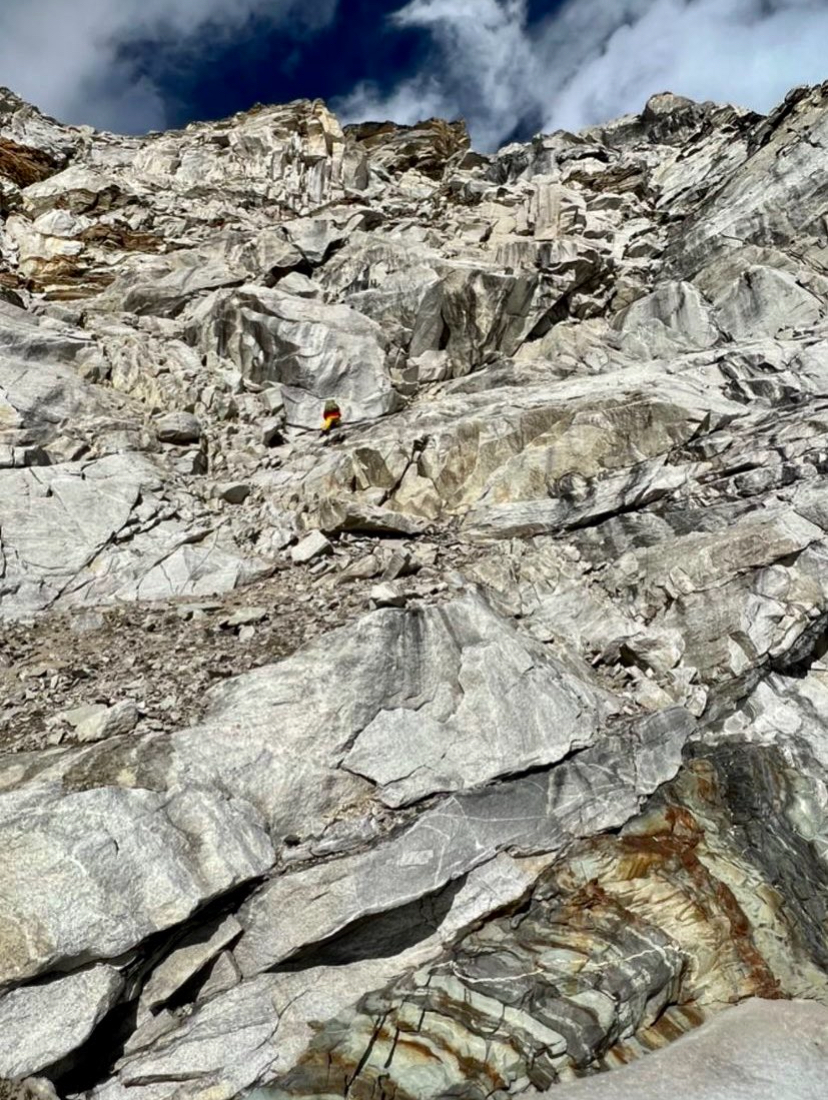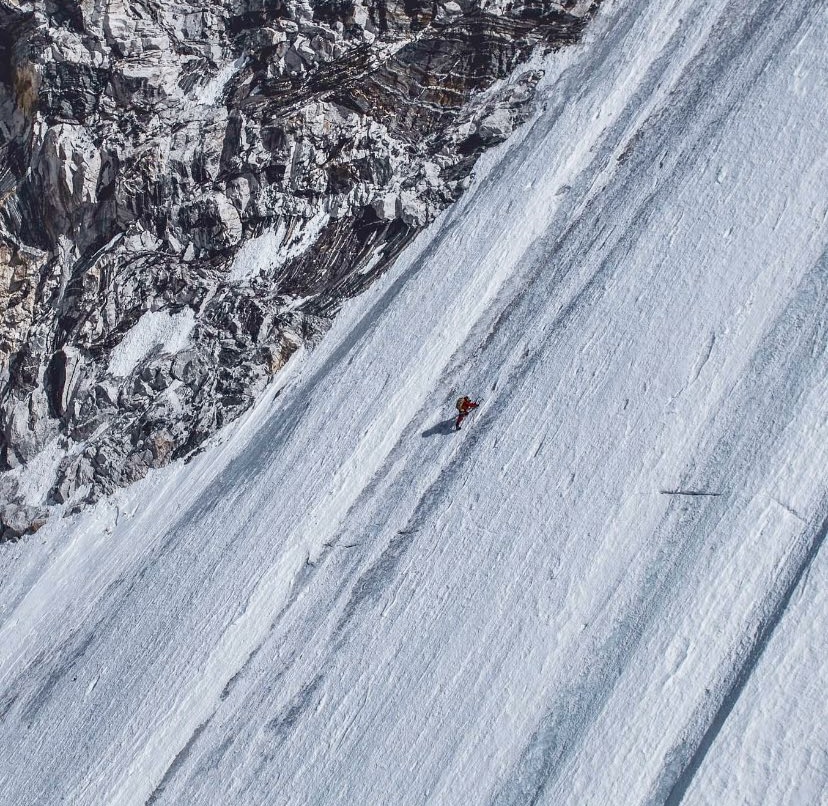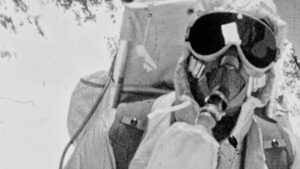Jost Kobusch is about to start his third solo Everest winter attempt via Lho La – the West Ridge – Hornbein Couloir. A few days ago, he went up 6,119m Lobuche East to acclimatize. Currently, he is organizing his stuff at Everest Base Camp.
Back in 2019, on Kobusch’s first attempt, a professional alpinist whose opinion he respected gave him a 0.1% chance of reaching even 6,000m. Thus, Kobusch started with a great deal of self-doubt. However, that year, he reached 7,366m.
The first difficult section of his route will be Lho La, the lowest point of the West Ridge. Lho La is a 6,006m col on the border between Nepal and China, north of the Western Cwm.

Jost Kobusch climbs up Lho La on a previous attempt. Photo: Daniel Hug/terragraphy
George Mallory and Guy Bullock discovered the col during the 1921 British Mount Everest reconnaissance expedition. At the time, they were exploring Tibet’s West Rongbuk Glacier, hoping it might lead to the summit of Everest. In the end, only Bullock actually reached Lho La.
Although its name means ”South Pass,” that is not the best way to describe it. First, it is a col, not a pass. Second, it lies west of Everest. The British called it Lo Lha simply because it was south of their position.
Change of name?
A Swiss attempt on Everest via the South Col – Southeast Ridge took place in the spring of 1952. Led by Edouard Wyss-Dunant, the party eventually gave up at a respectable 8,600m due to fatigue. After that expedition, they suggested changing the name Lho La to Khumbu La because it led up from the Khumbu Glacier. This could have allowed the South Col of Everest to inherit the Lho La name, since it is truly the col south of Everest.
But Nangpa La had been called Khumbu La in the past and was still sometimes called that name. So Lho La stayed where it was.
From Lho La, the route continues along the West Shoulder to the West Ridge. This prominent shoulder above Lho La is very dangerous. In the autumn of 1974, a major tragedy occurred here.

Photo: Jost Kobusch
First French expedition
Led by Gerard Devouassoux, the First French Everest Expedition wanted to climb the Lho La – West Ridge route without supplemental oxygen. They established Base Camp on Aug. 16, 1974, at the usual 5,400m site. The team included 11 French climbers and seven Sherpas.
The French planned to ascend via Lho La to the West Ridge via the West Shoulder. They believed this was safer than going through the Khumbu Icefall.
They established Camp 1 at 5,800, halfway between Lho La and Base Camp and 200m below Lho La. Then, on September 3, the party established Camp 2 at 6,400m on the West Shoulder. They did not go to Lho La but went straight up on the right, changing the route slightly.
On September 9, they set up Camp 3 at 6,900m, 300m below the top of the shoulder. Not only the French climbers but also the sirdar and the sherpas took part in the choice of the campsites. That day, they were all distributed in various camps. According to The Himalayan Database, there were:
- nine sherpas and Eric Lasserre in Camp 1
- six sherpas, Pierre Tarraiz, and the leader, Devouassoux, in Camp 2
- one sherpa, Claude Ancey, and Jean-Paul Balmat in Camp 3
The rest of the team was in Base Camp.
The monsoon normally should have stopped by the end of September, but that year, it started weakly but ended violently. However, no one had seen any avalanches on the western slopes of Everest before September 9.

The first section of the climb. Photo from one of Kobusch’s previous attempts
Tragedy strikes
On September 9 at about 7:10 pm, Georges Payot and the other members in Base Camp heard the sound of a huge avalanche up the mountain. Lasserre, who was in Camp 1 at the time, told Base Camp by walkie-talkie that the avalanche had passed about 200m from Camp 1 and 150m from Camp 2. He said that one of the tents in Camp 1 had been blown away, with Nima Wangchu Sherpa inside.
The real situation was even worse: The avalanche started at 7,000m, north of Camp 3, and hit Camp 1 and Camp 2. In addition to Nima Wangchu in Camp 1, Devouassoux, Pemba Dorje Sherpa, Nawang Lotuk Sherpa, Lhakpa Sherpa, and Sanu Wangel Sherpa had died in Camp 2.
Only the body of Nawang Lotuk, lying below Camp 1, was found.
Six people died that day. This ended the expedition. The rest of the team abandoned Base Camp in shock.

Jost Kobusch on one of his previous solo attempts. Photo: Daniel Hug/terragraphy
Willi Unsoeld was in Kathmandu when he heard about the accident. Unsoeld told a Reuters correspondent that that section of the West Ridge, from Lho La to the West Shoulder, is extremely steep. Avalanches can happen at any time, he said.
Kobusch’s solo attempt
On his first attempt, Kobusch experienced how difficult climbing Lho La and the shoulder was. But he says he feels much calmer this time than he did five years ago.
”I know myself and the route much better,” he admitted.
The German climber’s goal is to exceed 7,500m on this expedition.
In his book Ich Oben Allein (which could be translated as “Me, Above and Solo”), Kobusch wrote his thoughts about solitary climbing:
”Being solo also means being emotionally on your own. Because there is usually no one who can help you in an emergency. On your own, mistakes are taboo…[But] what scares others means freedom to me. I’m not responsible for anyone, and I alone deal with my faults. I can make any decision without having to justify myself to others. It’s all in my hands.”
Kobusch will start the climb in two days, on December 22.

Jost Kobusch. Photo: Jost Kobusch






